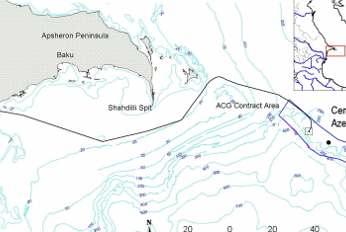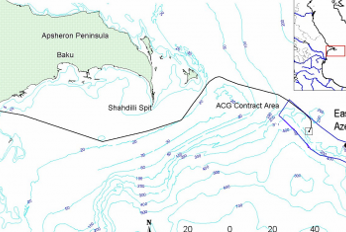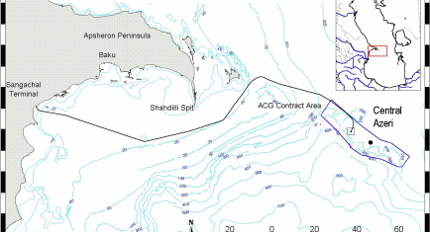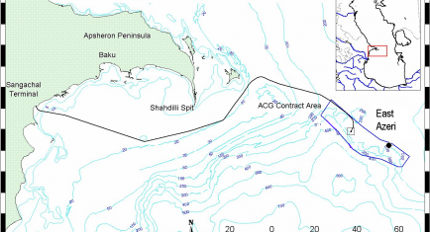Documents
This section features public documents and files uploaded by the stakeholders and custodians of the Caspian Sea environment.
 Central Azeri Environmental Survey July 2010 AmC Project 10502Tue, 17/04/2018 - 15:02Sampling was conducted from the vessel Svetlomor 2 by personnel from AmC, the Ministry of Ecology and Natural Resources (MENR) and SOCAR. Sediment samples for physical and chemical analysis consisted of 2 replicates, while 3 replicates were taken for biological analyses. Analyses were carried out at AmC Caspian Environmental+5
Central Azeri Environmental Survey July 2010 AmC Project 10502Tue, 17/04/2018 - 15:02Sampling was conducted from the vessel Svetlomor 2 by personnel from AmC, the Ministry of Ecology and Natural Resources (MENR) and SOCAR. Sediment samples for physical and chemical analysis consisted of 2 replicates, while 3 replicates were taken for biological analyses. Analyses were carried out at AmC Caspian Environmental+5
- Description
Sampling was conducted from the vessel Svetlomor 2 by personnel from AmC, the Ministry of Ecology and Natural Resources (MENR) and SOCAR. Sediment samples for physical and chemical analysis consisted of 2 replicates, while 3 replicates were taken for biological analyses. Analyses were carried out at AmC Caspian Environmental Laboratory.
Sediments around Central Azeri were very poorly sorted, the majority being a mixture of sand and gravel. At many stations, the two replicates were substantially different, indicating patchiness of physical characteristics on a small spatial scale (metres).
LAO was detected at 7 stations in 2010. There was little evidence of change at the majority of stations, and the overall area within which LAO was observed remains very similar to that observed in previous surveys. In general the hydrocarbon concentrations were low or very low and UCM and NPD content were indicative of weathered material being present throughout the survey area.
For the majority of trace metals the data show no clear trends or gradients which could be associated with platform activities. Three elements – barium, cadmium, and lead – exhibited very similar concentration patterns. These were the only elements which indicated a ‘footprint’ which was spatially related to the platform location. A similar association was evident in the 2008 data.
The macrobenthic community was numerically dominated by amphipods which were also the most taxonomically rich group. There was a general tendency towards lower species richness and abundance at stations to the north of, and immediately to the south of, the platform, as was also noted in 2008.
The 2010 data for sediment composition, chemistry and macrobenthic biology suggest that there is an area immediately around the platform in which some degree of sediment alteration is present, and where there is a slightly lower macrobenthic community biomass and diversity relative to more distant stations. However, there are no stations which could be considered biologically impoverished compared to previous surveys.
- Attached documents
- Metadata
- Year
- 2012
 East Azeri Environmental Survey July/August 2010 AmC Project 10503Mon, 16/04/2018 - 16:17Technical Summary Sampling was conducted from the vessel Svetlomor 2 by personnel from AmC, the Ministry of Ecology and Natural Resources (MENR) and SOCAR. Sediment samples for physical and chemical analysis consisted of 2 replicates, while 3 replicates were taken for biological analyses. Analyses were carried out at AmC Ca+5
East Azeri Environmental Survey July/August 2010 AmC Project 10503Mon, 16/04/2018 - 16:17Technical Summary Sampling was conducted from the vessel Svetlomor 2 by personnel from AmC, the Ministry of Ecology and Natural Resources (MENR) and SOCAR. Sediment samples for physical and chemical analysis consisted of 2 replicates, while 3 replicates were taken for biological analyses. Analyses were carried out at AmC Ca+5
- Description
Technical Summary
Sampling was conducted from the vessel Svetlomor 2 by personnel from AmC, the Ministry of Ecology and Natural Resources (MENR) and SOCAR. Sediment samples for physical and chemical analysis consisted of 2 replicates, while 3 replicates were taken for biological analyses. Analyses were carried out at AmC Caspian Environmental Laboratory.
The sediments around East Azeri were very poorly sorted with generally good agreement between replicate samples.Variation between metal concentrations was low.
Metal and hydrocarbon concentrations were, with the exception of Ba and Cd, within the range of baseline conditions for the ACG contract area, and in many instances were lower in 2010 than in 2008.
The condition of the macrobenthic community throughout the survey area was, in 2010, better than in 2008, and was closer to the original baseline conditions. There was no evidence that any physical or chemical parameter was associated with impaired community structure or function, although it was clear that the dominant taxonomic groups were more diverse and abundant in coarser sediments.
Specifically, the results of the 2010 survey show no evidence of sustained impact as a result of continuing platform drilling and production operations; there has (with the possible exception of Cd) been no evidence of direct contamination, and the diversity, abundance and biomass of the macrobenthic community has improved since 2008.
- Attached documents
- Metadata
- Year
- 2012
Document

Central Azeri Environmental Survey July 2010 AmC Project 10502
Document

